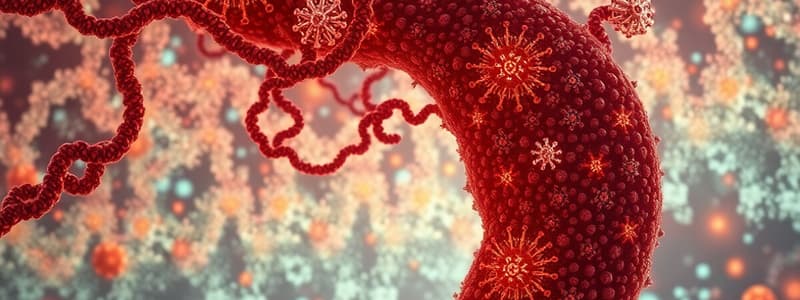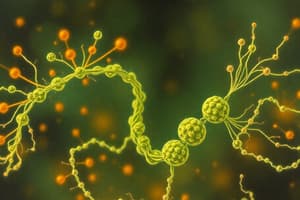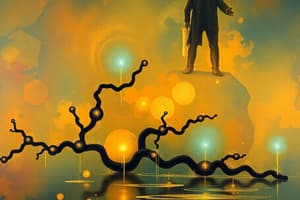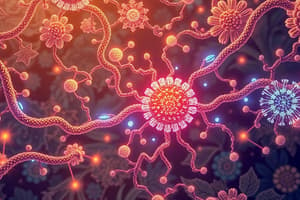Podcast
Questions and Answers
What type of glycosidic bond forms the linear chain of glycogen?
What type of glycosidic bond forms the linear chain of glycogen?
- β-(1,4)
- α-(1,4) (correct)
- α-(1,6)
- β-(1,6)
Which molecule is required to activate glucose 1-phosphate before it can be added to glycogen during synthesis?
Which molecule is required to activate glucose 1-phosphate before it can be added to glycogen during synthesis?
- CTP
- GTP
- ATP
- UDP (correct)
What is the primary function of glycogen in skeletal muscle?
What is the primary function of glycogen in skeletal muscle?
- To regulate blood glucose levels for the whole body
- To provide a rapid supply of glucose for the muscle itself (correct)
- To serve as a long term energy storage for the whole body
- To synthesize nucleotides for the muscle
What is the approximate percentage of the liver's weight accounted for by glycogen?
What is the approximate percentage of the liver's weight accounted for by glycogen?
What is the primary role of liver glycogen?
What is the primary role of liver glycogen?
What is the fate of glucose 1-phosphate obtained during glycogen degradation?
What is the fate of glucose 1-phosphate obtained during glycogen degradation?
Which of the following is a main product of the pentose phosphate pathway?
Which of the following is a main product of the pentose phosphate pathway?
What is the primary role of ribose 5-phosphate produced in the pentose phosphate pathway?
What is the primary role of ribose 5-phosphate produced in the pentose phosphate pathway?
Approximately how many ATP molecules are generated from one molecule of NADH in the electron transport chain?
Approximately how many ATP molecules are generated from one molecule of NADH in the electron transport chain?
Which of the following molecules directly enters the electron transport chain (ETC) at Complex II?
Which of the following molecules directly enters the electron transport chain (ETC) at Complex II?
In the context of cellular respiration, what is the net ATP production from glycolysis in an oxidative state?
In the context of cellular respiration, what is the net ATP production from glycolysis in an oxidative state?
What is the primary role of the malate-aspartate shuttle in cellular respiration?
What is the primary role of the malate-aspartate shuttle in cellular respiration?
How many ATP are produced by the full oxidation of one glucose molecule, considering both substrate-level and oxidative phosphorylation?
How many ATP are produced by the full oxidation of one glucose molecule, considering both substrate-level and oxidative phosphorylation?
Which process is responsible for synthesizing glucose from non-carbohydrate precursors?
Which process is responsible for synthesizing glucose from non-carbohydrate precursors?
What is the immediate product of glucose inside the cell that is formed by the action of hexokinase?
What is the immediate product of glucose inside the cell that is formed by the action of hexokinase?
Which enzyme is important in the regulation of gluconeogenesis process?
Which enzyme is important in the regulation of gluconeogenesis process?
Besides diet and gluconeogenesis, what is another primary source for blood glucose?
Besides diet and gluconeogenesis, what is another primary source for blood glucose?
Why is glycogen degradation considered to be a more rapid source of glucose compared to gluconeogenesis?
Why is glycogen degradation considered to be a more rapid source of glucose compared to gluconeogenesis?
What is the primary role of bioenergetics in biological systems?
What is the primary role of bioenergetics in biological systems?
A reaction with a negative ΔG is considered:
A reaction with a negative ΔG is considered:
Which of the following best represents the net change in free energy (ΔG) for a coupled reaction where ΔG01 = -5 kcal/mol and ΔG02 = +2 kcal/mol?
Which of the following best represents the net change in free energy (ΔG) for a coupled reaction where ΔG01 = -5 kcal/mol and ΔG02 = +2 kcal/mol?
What is the primary function of the electron transport chain (ETC) in ATP production?
What is the primary function of the electron transport chain (ETC) in ATP production?
What is substrate-level phosphorylation?
What is substrate-level phosphorylation?
What is the role of NADH and FADH2 in cellular respiration?
What is the role of NADH and FADH2 in cellular respiration?
What is the main purpose of the pentose phosphate pathway?
What is the main purpose of the pentose phosphate pathway?
Which process converts glucose to pyruvate?
Which process converts glucose to pyruvate?
Which of the following represents the correct net ATP production of glycolysis assuming no further reactions with the products?
Which of the following represents the correct net ATP production of glycolysis assuming no further reactions with the products?
What is the function of fermentation in the absence of oxygen?
What is the function of fermentation in the absence of oxygen?
Where does the citric acid cycle (TCA cycle) mainly occur in eukaryotes?
Where does the citric acid cycle (TCA cycle) mainly occur in eukaryotes?
What is the primary function of the citric acid cycle (TCA cycle)?
What is the primary function of the citric acid cycle (TCA cycle)?
The conversion of pyruvate to acetyl-CoA links which two metabolic processes?
The conversion of pyruvate to acetyl-CoA links which two metabolic processes?
What is the role of the proton gradient that is formed during the electron transport chain?
What is the role of the proton gradient that is formed during the electron transport chain?
What are the two stages of glycolysis?
What are the two stages of glycolysis?
Flashcards
What is the Electron Transport Chain (ETC)?
What is the Electron Transport Chain (ETC)?
The Electron Transport Chain (ETC) is a series of protein complexes embedded in the inner mitochondrial membrane. Electrons are passed from one complex to another, releasing energy that is used to pump protons across the membrane, creating a proton gradient.
How do NADH and FADH2 play a role in the ETC?
How do NADH and FADH2 play a role in the ETC?
NADH and FADH2 are electron carriers that deliver electrons to the ETC. NADH enters at Complex I, while FADH2 enters at Complex II.
How does the ETC contribute to ATP synthesis?
How does the ETC contribute to ATP synthesis?
The ETC pumps protons across the inner mitochondrial membrane, creating a proton gradient. This gradient drives the synthesis of ATP by ATP synthase, a protein complex that uses the energy of proton flow to create ATP.
Explain glycolysis in the context of ATP production.
Explain glycolysis in the context of ATP production.
Signup and view all the flashcards
What is the Citric Acid Cycle (TCA cycle) and its role in ATP production?
What is the Citric Acid Cycle (TCA cycle) and its role in ATP production?
Signup and view all the flashcards
Explain the malate-aspartate shuttle.
Explain the malate-aspartate shuttle.
Signup and view all the flashcards
What is the glycerol 3-phosphate shuttle?
What is the glycerol 3-phosphate shuttle?
Signup and view all the flashcards
What is glycogen and its role in energy storage?
What is glycogen and its role in energy storage?
Signup and view all the flashcards
What is gluconeogenesis?
What is gluconeogenesis?
Signup and view all the flashcards
What is the Pentose Phosphate Pathway (PPP) and its functions?
What is the Pentose Phosphate Pathway (PPP) and its functions?
Signup and view all the flashcards
Bioenergetics
Bioenergetics
Signup and view all the flashcards
Free Energy Change (ΔG)
Free Energy Change (ΔG)
Signup and view all the flashcards
ATP (Adenosine Triphosphate)
ATP (Adenosine Triphosphate)
Signup and view all the flashcards
Substrate-Level Phosphorylation
Substrate-Level Phosphorylation
Signup and view all the flashcards
Oxidative Phosphorylation
Oxidative Phosphorylation
Signup and view all the flashcards
Glycolysis
Glycolysis
Signup and view all the flashcards
Gluconeogenesis
Gluconeogenesis
Signup and view all the flashcards
Pentose Phosphate Pathway
Pentose Phosphate Pathway
Signup and view all the flashcards
Glycogenolysis
Glycogenolysis
Signup and view all the flashcards
Glycogenesis
Glycogenesis
Signup and view all the flashcards
Citric Acid Cycle (TCA Cycle)
Citric Acid Cycle (TCA Cycle)
Signup and view all the flashcards
Electron Transport Chain (ETC)
Electron Transport Chain (ETC)
Signup and view all the flashcards
Oxidative Phosphorylation
Oxidative Phosphorylation
Signup and view all the flashcards
Fermentation
Fermentation
Signup and view all the flashcards
Pyruvate Dehydrogenase Complex (PDC)
Pyruvate Dehydrogenase Complex (PDC)
Signup and view all the flashcards
Pyruvate Transport
Pyruvate Transport
Signup and view all the flashcards
What is glycogen?
What is glycogen?
Signup and view all the flashcards
What is the function of glycogen in skeletal muscle?
What is the function of glycogen in skeletal muscle?
Signup and view all the flashcards
What is the function of glycogen in the liver?
What is the function of glycogen in the liver?
Signup and view all the flashcards
What is glycogen synthesis?
What is glycogen synthesis?
Signup and view all the flashcards
What is glycogen degradation?
What is glycogen degradation?
Signup and view all the flashcards
What is glycolysis?
What is glycolysis?
Signup and view all the flashcards
What is the pentose phosphate pathway?
What is the pentose phosphate pathway?
Signup and view all the flashcards
Study Notes
Bioenergetics
- Bioenergetics is the transfer and utilization of energy in biological systems
- Bioenergetics predicts if a process is possible, whereas kinetics measures the reaction rate
- Enzymes cannot make a reaction happen on their own
- Energy difference (ΔG) = (Final E) - (Initial E). A negative ΔG indicates a spontaneous, exergonic reaction. A positive ΔG indicates a nonspontaneous, endergonic reaction.
- The change in free energy of a reaction (ΔG) is determined by the difference in energy between the products and reactants.
- Enzymes don't change ΔG, they lower the activation energy needed for a reaction to occur
ATP Production
- ATP production occurs through two main pathways:
- Substrate-level phosphorylation: Direct transfer of a phosphate group from a phosphorylated intermediate to ADP to form ATP (e.g., in glycolysis)
- Oxidative phosphorylation: Production of ATP by the electron transport chain (ETC), fueled by electrons from NADH and FADH2 (e.g., in mitochondria)
Carbohydrate Metabolism
- Carbohydrates are the primary source of energy for the body.
- Glycolysis is the breakdown of glucose into pyruvate, producing ATP and NADH.
- Glycogenesis is the synthesis of glycogen from glucose.
- Glycogenolysis is the breakdown of glycogen into glucose.
- Gluconeogenesis is the synthesis of glucose from non-carbohydrate precursors (like amino acids).
- The pentose phosphate pathway produces NADPH and ribose 5-phosphate.
TCA Cycle
- The TCA cycle (also known as the citric acid cycle) is an important metabolic pathway in the mitochondria.
- It plays an essential role in energy production. Pyruvate, produced from glycolysis, is converted to Acetyl-CoA to enter the TCA cycle.
- The TCA cycle generates NADH and FADH2 (electron carriers) and produces CO₂.
- Intermediates from the TCA cycle can be used to synthesize various biomolecules, demonstrating its biosynthetic role
Oxidative Phosphorylation and ETC
- The electron transport chain (ETC) is a series of protein complexes in the inner mitochondrial membrane.
- NADH and FADH₂ (produced from glycolysis and TCA cycle) deliver electrons to the ETC.
- The energy released from electron transfer through the ETC is used to pump protons (H+) across the membrane creating an electrochemical gradient.
- ATP synthase uses this gradient to synthesize ATP.
Pentose Phosphate Pathway
- The pentose phosphate pathway is an alternative metabolic pathway for glucose.
- It produces NADPH, essential for reducing agents in biosynthetic processes, and ribose 5-phosphate required for nucleotide synthesis and nucleic acid synthesis.
- The oxidative reactions of this pathway are irreversible
- The nonoxidative reactions are reversible.
Glycogen
- Storage form of glucose in animals
- Found in liver and muscle tissue
- Branched structure that provides multiple points for breakdown when needed
- The branching allows for rapid glucose release and storage when energy is demanded or excess fuel is available for storage
Hormonal Regulation of Glycolysis
- Insulin stimulates glycolysis (used to increase glucose from blood).
- Glucagon inhibits glycolysis (used to decrease glucose from blood).
Glycolysis: NAD+ Regeneration
- NAD+ serves as an electron acceptor during glycolysis. When O2 is present, NADH produced by glycolysis can be oxidized via oxidative phosphorylation in the mitochondria.
- When O2 is absent, fermentation pathways (e.g., lactate production) regenerate NAD+ in the cytoplasm allowing anaerobic respiration to proceed.
Malate Aspartate Shuttle
- A mechanism to transfer electrons from NADH in the cytosol to the mitochondrial matrix.
- Through a series of reactions, NADH from glycolysis in the cytoplasm is converted to NADH within the mitochondrial matrix, allowing for its use in oxidative phosphorylation.
Glycerol 3-Phosphate Shuttle
- Another method that transfers high energy electrons from the cytoplasm to the mitochondria.
- Conversion of NADH in the cytoplasm to FADH2 in the mitochondria to support oxidative phosphorylation without transferring NADH directly
Studying That Suits You
Use AI to generate personalized quizzes and flashcards to suit your learning preferences.




